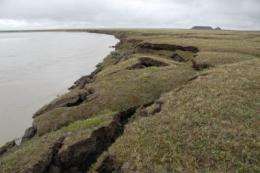Thawing permafrost 50 million years ago led to extreme global warming events

In a new study reported in Nature, climate scientist Rob DeConto of the University of Massachusetts Amherst and colleagues elsewhere propose a simple new mechanism to explain the source of carbon that fed a series of extreme warming events about 55 million years ago, the Paleocene-Eocene Thermal Maximum (PETM), and a sequence of similar, smaller warming events afterward.
"The standard hypothesis has been that the source of carbon was in the ocean, in the form of frozen methane gas in ocean-floor sediments," DeConto says. "We are instead ascribing the carbon source to the continents, in polar latitudes where permafrost can store massive amounts of carbon that can be released as CO2 when the permafrost thaws."
The new view is supported by calculations estimating interactions of variables such as greenhouse gas levels, changes in the Earth's tilt and orbit, ancient distributions of vegetation, and carbon stored in rocks and in frozen soil.
While the amounts of carbon involved in the ancient soil-thaw scenarios was likely much greater than today, implications of the study appear dire for the long-term future as polar permafrost carbon deposits have begun to thaw due to burning fossil-fuels, DeConto adds. "Similar dynamics are at play today. Global warming is degrading permafrost in the north polar regions, thawing frozen organic matter, which will decay to release CO2 and methane into the atmosphere. This will only exacerbate future warming in a positive feedback loop."
He and colleagues at Yale, the University of Colorado, Penn State, the University of Urbino, Italy, and the University of Sheffield, U.K., designed an accurate model―elusive up to now―to satisfactorily account for the source, magnitude and timing of carbon release at the PETM and subsequent very warm periods, which now appear to have been triggered by changes in the Earth's orbit.
Earth's atmospheric temperature is a result of energy input from the sun minus what escapes back to space. Carbon dioxide in the atmosphere absorbs and traps heat that would otherwise return to space. The PETM was accompanied by a massive carbon input to the atmosphere, with ocean acidification, and was characterized by a global temperature rise of about 5 degrees C in a few thousand years, the researchers point out. Until now, it has been difficult to account for the massive amounts of carbon required to cause such dramatic global warming events.
To build the new model, DeConto's team used a new, high-precision geologic record from rocks in central Italy to show that the PETM and other hyperthermals occurred during periods when Earth's orbit around the sun was both highly eccentric (non-circular) and oblique (tilted). Orbit affects the amount, location and seasonality of solar radiation received on Earth, which in turn affects the seasons, particularly in polar latitudes, where permafrost and stored carbon can accumulate.
They then simulated climate-ecosystem-soil interactions, accounting for gradually rising greenhouse gases and polar temperatures plus the combined effects of changes in Earth orbit. Their results show that the magnitude and timing of the PETM and subsequent hyperthermals can be explained by the orbitally triggered decomposition of soil organic carbon in the circum-Arctic and Antarctica.
This massive carbon reservoir at the poles "had the potential to repeatedly release thousands of petagrams of carbon to the atmosphere-ocean system once a long-term warming threshold was reached just prior to the PETM," DeConto and colleagues say. Until now, Antarctica, which today is covered by kilometers of ice, has not been appreciated as an important player in such global carbon dynamics.
In the past, "Antarctica and high elevations of the circum-Arctic were suitable locations for massive carbon storage," they add. "During long-term warming, these environments eventually reached a climatic threshold," with permafrost thaw and the sudden release of stored soil carbon triggered during the Earth's highly eccentric orbits coupled with high tilt.
The model described in the paper also provides a mechanism that helps to explain relatively rapid recovery from hyperthermals associated with orbital extremes occurring about every 1.2 million years, which had until now been difficult.
Overall, they conclude, "an orbital-permafrost soil carbon mechanism provides a unifying model accounting for the salient features of the hyperthermals that other previously proposed mechanisms fail to explain." Further, if the analysis is correct and past extreme warm events can be attributed to permafrost loss, it implies that thawing of permafrost in similar environments observed today "will provide a substantial positive feedback to future warming."
More information: www.nature.com/nature/journal/ … ull/nature10929.html
Provided by University of Massachusetts at Amherst



















